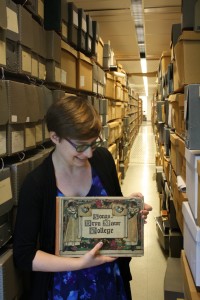For Brenna’s previous reflections on this topic, see Silence in the Archives, Part I: Inviting Inquiry.

Brenna Levitin ’16 in the College Archives. How do we study lesser-known aspects of Bryn Mawr student life?
Since my unconference session at PhillyDH@Penn, I’ve spent many hours mulling over ways to represent a project which each day becomes more complex. Because of the silence of our archives on the topic of LGBT life at Bryn Mawr, my project now relies heavily on personal accounts, discovered both through oral histories and informational interviews with alumnae/i and members of the faculty and administration.
Oral accounts are notoriously tricky: often narrators mix up names or dates, and personal narratives color everything. It’s the job of the historian (or historian-in-training) to interpret the narrator’s stories and to position them within both the overall narrative and the narrative of their life. It’s important to think critically about what might have shaped a person’s narrative so that we as historians do not naively accept everything we are told: we may hear two accounts which are factually divergent but represent equally valid experiences.
As I slid down the archival silence rabbit hole, it became clear that Omeka, the technology which The Greenfield Digital Center typically uses to create digital exhibits, would not be able to contain a decentralized, testimony-based project such as this one. My supervisor, a more experienced digital humanist than I, suggested an alternate program: Scalar.
 For those unfamiliar, Scalar is an open-source, online tool which allows scholars to build non-linear or multi-linear multimedia “books.” So far, Scalar appears to be a better tool for this project because it can showcase oral histories alongside blocks of text and images. I am especially enchanted by Scalar because it allows items to annotate or comment on other items, a great way to represent many, divergent stories, and because it allows multiple paths. As I build the exhibit, I’ll be able to specify not only an overall, linear path, but also a path which contains major events held by LGBT student groups or one with all of the reported instances of homophobia.
For those unfamiliar, Scalar is an open-source, online tool which allows scholars to build non-linear or multi-linear multimedia “books.” So far, Scalar appears to be a better tool for this project because it can showcase oral histories alongside blocks of text and images. I am especially enchanted by Scalar because it allows items to annotate or comment on other items, a great way to represent many, divergent stories, and because it allows multiple paths. As I build the exhibit, I’ll be able to specify not only an overall, linear path, but also a path which contains major events held by LGBT student groups or one with all of the reported instances of homophobia.
This multi-linear capacity means that not only are we not tied to one narrative, something which history struggles to accommodate at the best of times, but we are also free to portray the richness and diversity of the LGBT experience at Bryn Mawr. Some people loved college life, others didn’t; some were head of the Rainbow Alliance while others stuck to their tight-knit foursome. Every time that I send an email to a community member to request an interview, I include the fact that I’m not just looking for one universal, positive, “gay Bryn Mawr” experience. It’s important to me to amplify the voices of all; for without those voices, our tenuous connection to our history as an LGBT institution would fray irreparably.
Really really excited that someone is working on this. Really really hoping that this winds up being LGB and T, rather than LGb. I’m aware that sometimes discussing trans or gender non-conforming folks adds whole new dimensions to work that genuinely are beyond the expertise or time that a researcher has available, but also that the history of gender non-conforming folks and LGB folks is deeply intertwined, difficult to pull apart because of the ways identity categories have shifted. Like, you can ask (and this may not be a useful question for gaining insight into past lives, but you can ask) would some 19th and early 20th c. inverts take to the terminology of the contemporary trans community, if they knew of it?
More directly related to Bryn Mawr: I’m super curious as to whether any of the stereotypes of the female invert and/or the butch lesbian clung to the stereotypical jock (a representation can be seen here: http://greenfield.brynmawr.edu/exhibits/show/athletics-and-phys-ed/item/619)
Looking forward to seeing where this work goes!
G Ragovin
BMC ’10
writer, archivist, historian
Thank you for your comment! I agree that representing the T in LGBT is important, and I have been in contact with several trans alums throughout the process. The final exhibit will hopefully reflect the multitude of experiences which I’ve encountered, including, of course, trans voices. As one of the first official looks back into our LGBT history, the project (and I) have a responsibility to represent faithfully the experiences of LGBT alumnae/i and community members. It’s also important to remember that this is a first attempt at a deep history, not /the/ LGBT history.
Researching trans experiences in a time period where few identified as trans has certainly been challenging, but enlightening!
-Brenna
Pingback: LGB(T): the problem of gender identity in a historical narrative | Educating Women